
© Maarten Holl. (Click image for larger version)
Royal New Zealand Ballet
Giselle
Production and Choreography: Johan Kobborg & Ethan Stiefel,
choreography after Marius Petipa
Music: Adolphe Adam
Scenic Design: Howard C Jones
Costume design: Natalia Stewart
Lighting Design: Kendall Smith
Conductor: Michael Lloyd
Wellington, St James Theatre
7/8 November 2012
www.nzballet.org.nz
www.nzballet.org.nz/giselle
Interview: Ethan Stiefel (October 2012)
The new production of Giselle by Ethan Stiefel and Johan Kobborg for the Royal New Zealand Ballet, which premiered last week, is more than just a “restaging” or “re-working” of this ultimate Romantic classical ballet. What this creative and glorious revisiting has achieved is an enrichment and revitalization of everything the work holds dear and, at the same time, a wonderful showcase for this company of 32 talented young dancers/
The narrative (a moral tale about class boundaries in the 1841 original) has been re-visited to ensure it has relevance for today’s audiences, with the emphasis firmly placed on dramatically credible, emotionally rich interpersonal interactions. Anything which fails to serve the narrative has been removed. Linkages between events have been strengthened (compared to some Giselle’s I’ve seen), and the motivation of leading characters has been made evident to increase credibility – Albrecht’s aide, Wilfrid, for example, is completely focused on ensuring his master’s wellbeing in every way, yet has no choice but to give way to Albrecht’s orders; and Hilarion carefully pieces together the clues to Albrecht’s real identity, revealing it to vindicate his own love for Giselle.
A fitting narrative frame has been added, making the plot a cohesive whole as Albrecht’s story. This frame is cleverly presented through visual design elements and lighting. The front cloth shows a skeletal tree whose branches are sprinkled with small red leaves – implying autumn. The leaves are tiny red hearts and small flying things, like fireflies, blink on and off amongst them as the music begins. Slowly the front cloth rises to reveal the tree’s roots burrowing deep into the earth, forming a dark, shadowy heart below ground, and through the roots we see a spectral figure, an older man in a full-length fur-collared cloak, with hands held despairingly to his deeply creased face. As his hands drop to his side, he appears to be grieving, haunted, anguished. He reaches into his coat to pull out a rose as he starts to move backward into the darkness. He is replaced by the rustic architecture of the peasant village of Act 1, but subsequently re-appears to mark the start and end of each act, with the final coda of Act 2 closing the narrative arc to reveal what happens to Albrecht later in his life.

© Ross Brown. (Click image for larger version)
The set design by Howard Jones is highly effective in setting the scene throughout the work, with clever use of transparent scrim panels combined with hand-painted cut-out shapes which become three dimensional tree trunks, branches and leaves under Kendall Smith’s lighting. The scenic backcloth provides a view of the landscape, with the peasant village sited beneath mountain cliffs where the nobles live in a castle. Dividing the two sites of habitation is a tangled, dense old forest with some clearings and just enough space between rows of trees for the Wilis to flit through, ending near the village cemetery. The village is represented simply by two rustic wooden buildings clustered either side of an open space and a pathway beyond leading to the fields and cemetery.
The choreography has been polished up, tightened a little without sacrificing any of the hallmark sequences. Some new segments have been added, most notably an expanded solo full of leaps which rival Albrecht’s to make Hilarion a more credible competitor for Giselle’s heart; and the choreography has been tweaked here and there the better to support the narrative logic. All the characters are clearly integrated into the action.
Giselle’s mother, for example, is the village dressmaker and is evidently much respected. She presents a young bride-to-be with her wedding dress, while Giselle watches, and subsequently reminds Giselle about the legend of the Wilis, warning that a broken heart may be more than a momentary thing. The bride and her groom become the festive focus of village celebrations which dance across the ground where the nobles had trod, reclaiming it symbolically. The radiant bridal couple dances the Peasant Pas de Deux, in the process setting “real love” at the centre of village life. When the bride tosses her bouquet, Giselle catches it, and gives Albrecht a rose from it for his buttonhole. Later, he places that rose on her grave.
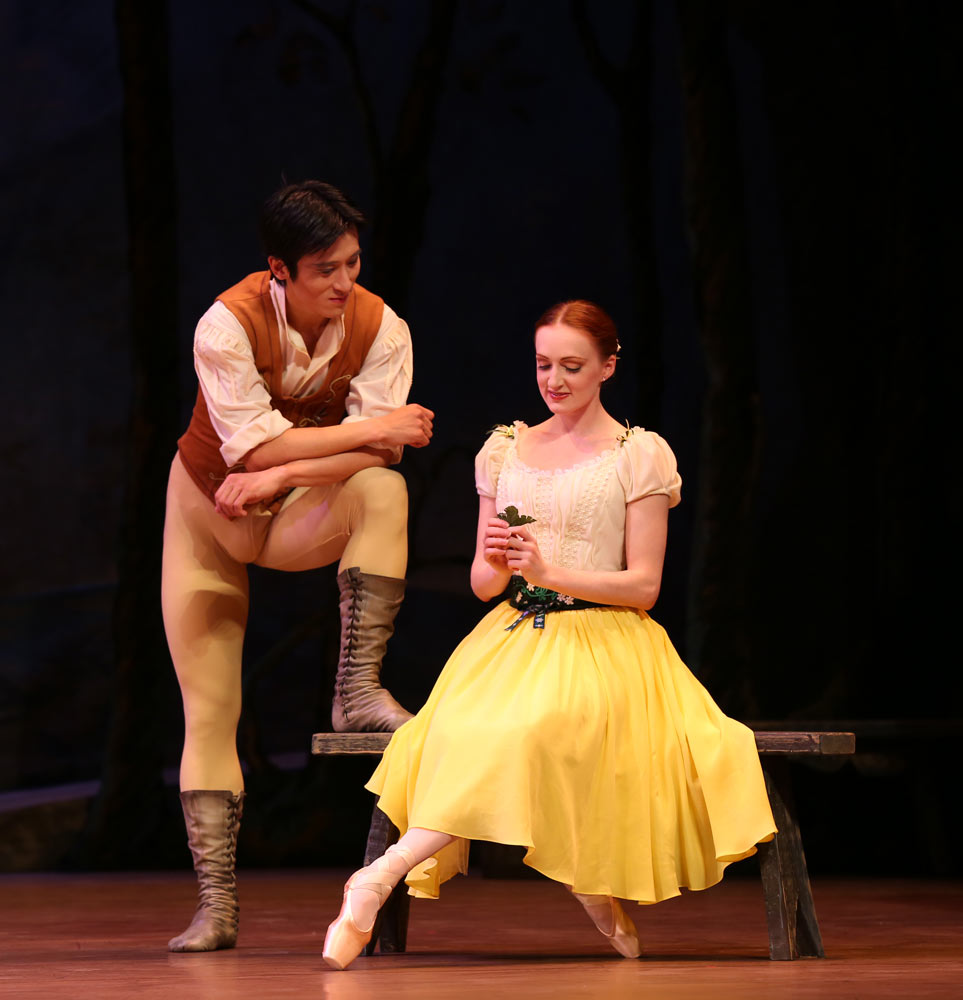
© Evan Li. (Click image for larger version)
In the midst of the wedding celebrations Giselle and Albrecht slip away to enjoy their own private moments, and return again all aglow as if they have never been missing. They join the dancing, Albrecht quickly picking up the footwork in circle and chain dances. Giselle falters at one point and has to stop dancing, her weak heart making its presence known; and subsequently the whole village looks on in horror when Giselle falls dead at Albrecht’s feet, the shock of his real identity, his betrayal of her and the ending of her dreams, too much to bear.
The dancing is demanding throughout the work’s 110 minutes, and the company has never looked better – technically poised and polished, lyrically perfect, and expressively convincing. The majority of dancers are younger than 32 and have come from all over the world to be in this company. Most have been here at least five years, and are highly committed to staying. That they are at their best right now is hardly surprising, given the input they have had over the past six weeks from Stiefel and Kobborg, Gillian Murphy (of ABT and who is the Royal NZ Ballet’s Principal Guest Artist), and coach Amanda McKerrow. In addition they have been given responsibility for their own interpretations of the characters they portray, and there’s a strong feeling of ownership in the company’s performance.
There are three casts for the current tour of 23 performances across NZ. Regional orchestras play the Adolphe Adam score in Wellington and Auckland under the direction of Michael Lloyd. On opening night, LLoyd pretty much danced across the stage himself in delight at the polished playing of the Vector Wellington Orchestra.
Leading international dancers Gillian Murphy and ex-patriate New Zealand dancer Andrew Bowman (for a decade a principal dancer with the Royal Danish Ballet) are in different casts. Murphy is dancing Giselle with Qi Huan as Albrecht, in Cast A, and Bowman is dancing Albrecht with Antonia Hewitt as Giselle, in Cast B. Rising 20-something dancers Lucy Green and Kohei Iwamoto, are yet to perform the lead roles, but both have been compelling to watch as bride and groom in different casts. There is also the possibility of a fourth cast in the final week when Bowman is not available.
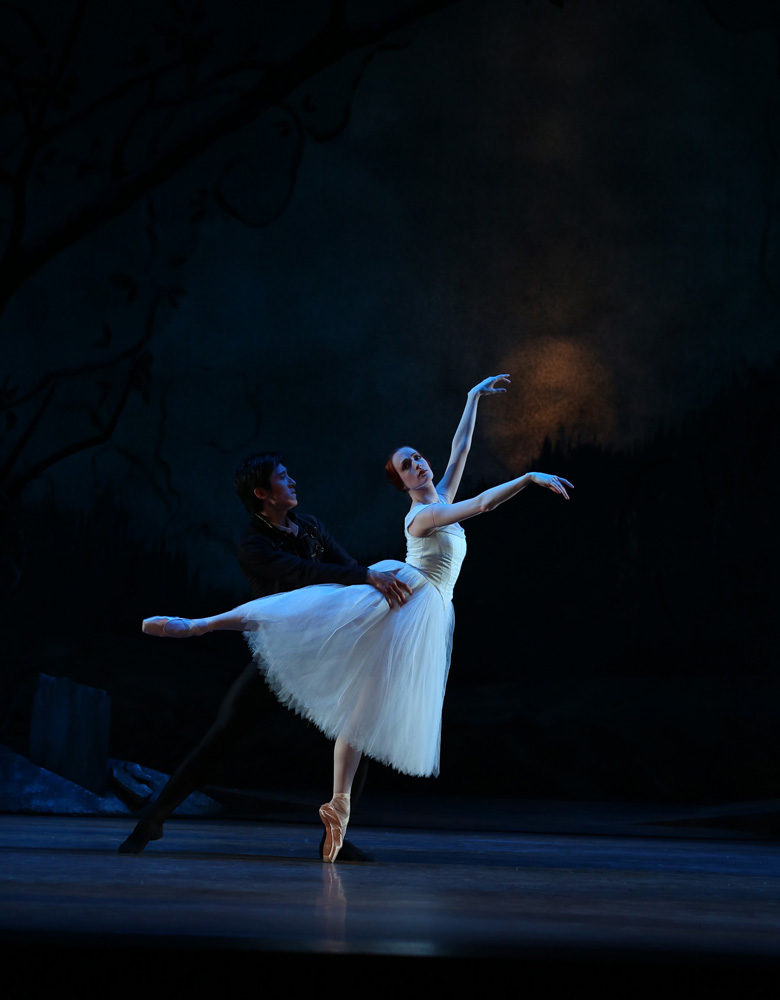
© Evan Li. (Click image for larger version)
In Cast A, Murphy and Huan are utterly riveting and beautifully matched. Huan is an ardent Albrecht, utterly entranced by Giselle and is considerably taken aback by his own stupidity when he realizes he has betrayed her. His dance to death is breathtaking and he convinces you that he has given every scrap of energy just as dawn arrives. Technically he is on fire, and we have never seen him dance like this before. He is well able to fulfill the challenge and is relishing every moment.
Murphy’s Giselle is at first demure and hesitant, only slowly entering into the game of wooing. Later, intoxicated with the attention, she slips away with Albrecht without a backward glance. Her “mad scene” is credible, and as a Wili her compassion for Albrecht is palpable. Her technique is impeccable, her timing perfect, her phrasing beautiful, and she is utterly in control of sustained balances and deepening arabesques, uberfast spins and that whipping series of pirouettes that everyone watches for. When she hands Albrecht back the rose at her grave, there’s no doubt that she is making her final farewell.
In Cast B Hewitt and Bowman are also well matched, both tall and willowy, spirited dancers. Bowman’s Albrecht is full of desire for Giselle, and he is a sensual, flirtatious man, slinking into the village and listening at her door while he figures out his moves. He is very soon hooked on her beauty and spirit, and wants to spend all his time with her. Subsequently caught out in his own duplicitous actions, he is at first completely in denial – he would never have done anything so stupid. When he realizes she really is dead, he is utterly distraught. In the dance to death (or dawn), his soaring leaps and sure partnering are most impressive, and every stumble and crumpling fall looks so real that you wonder if he is going to be able to get up and carry on.
Hewitt as Giselle is certainly aware of Albrecht’s intentions, and she playfully keeps him at a distance until it suits her to have him closer. There’s a certain insouciance in their demeanour when they return from dallying, and a flirtatiousness that continues through their dancing in Act 1. Ultimately though, his betrayal of her is deeply enough felt to cause her death, and the shock of her collapse is convincing. Later, as a Wili, she is torn between allegiances, and ultimately makes it possible for him to survive til dawn and win his freedom. Throughout, her technical command is clean and sure, her balances well sustained, spins and leaps perfectly pitched and her characterization is subtly nuanced, compelling to watch.
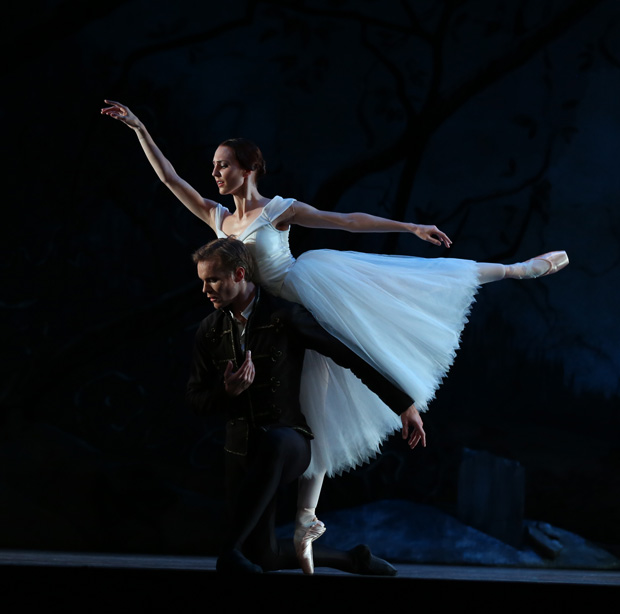
© Evan Li. (Click image for larger version)
The Hilarions (Jacob Chown in Cast A and Dimitri Kleoris in Cast B) are very impressive both technically and expressively. Chown takes a more threatening , accusatory manner which Giselle simply rejects, and Kleoris hangs back with his friends waiting for the “right moment” to declare his love, ultimately leaving his run too late as Giselle has already given her heart to Albrecht.
The corps de ballet is constantly on the move and the women in particular seldom get a break, making the transition from peasants or nobles in Act 1 to Wilis in Act 2 – always beautifully dressed in costumes designed by Natalia Stewart. The peasants are in earth tones: pants and skirts in browns and greens, ochres and grape shades, with cream shirts and embroidered vests and contrasting cummerbunds. The nobles are in quasi-Edwardian clothing, high fashion for Bathilde and the Duke, and formal hunting gear for the rest.
The fifteen Wilis are most beautifully arrayed in white, with veils covering their bodies to the hips, over silk bodices and calf-length layered tulle skirts, and they move en masse, en pointe, in picture perfect ranks and lines. The veils float and cling as the Wilis flit through the forest and move in formation, but when it is time to dance the men to death the veils are discarded to reveal their faces. Wili generals Moyna and Zulma (Lucy Green and Mayu Tanigaito in Cast A and Clytie Campbell with Ginny Gan in Cast B) are forceful figures, seizing first Hilarion and later Albrecht by both hands, forcing them to dance in corkscrew patterns and to keep moving when they lag, leaving no doubt at all about the intended finale of this particular kind of dance.
The Wili leader, Myrtha, (Abigail Boyle as a cold, remote figure in Cast A, and Lucy Balfour as one with a little more humanity in Cast B) is a world-weary figure – she’s seen enough of this maltreatment of young women and she wants it to stop. She dances out her own back story: the glories of her youth, the intensity of love, and the ghastliness of love betrayed – and recommits herself to the task at hand. When Giselle asks for mercy, she is implacable. No she will not yield: that man must be punished. And when the dawn comes she is shocked to have to let her foe go free.
So there’s perhaps no surprise at Myrtha’s demeanour in the final coda, appearing to rejoice as she converges on the older Albrecht mourning at Giselle’s grave, with the Wilis close behind her…
There is much international interest in this production of Giselle. It will be performed on tour in China (5 cities) during April 2013 as part of the company’s 60th birthday celebrations. And the company hope to tour it more widely internationally in future – it’s certainly a fine calling card.










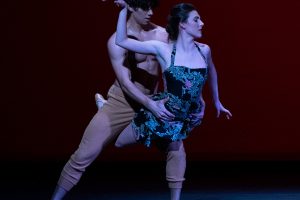
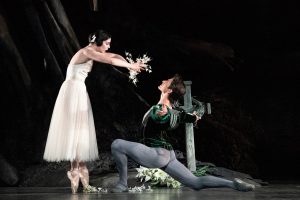
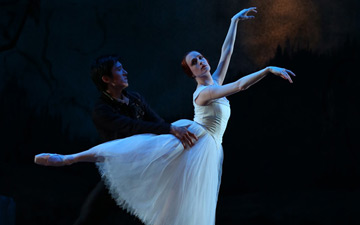
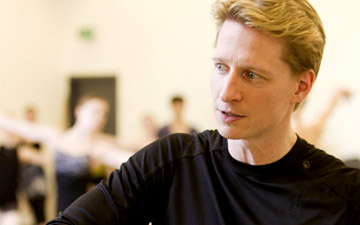
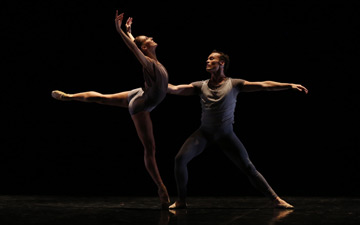
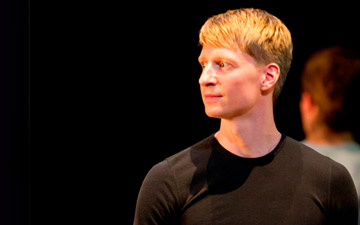

You must be logged in to post a comment.